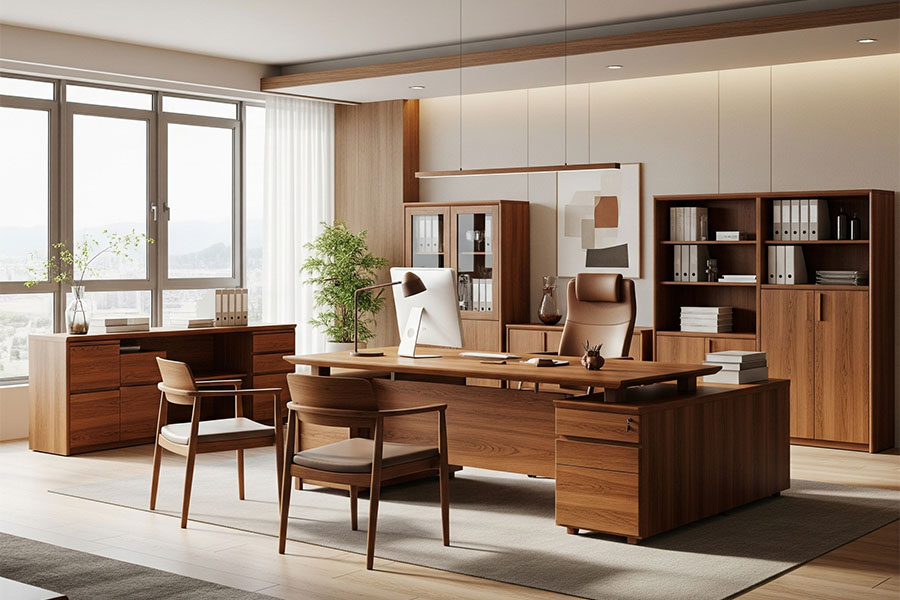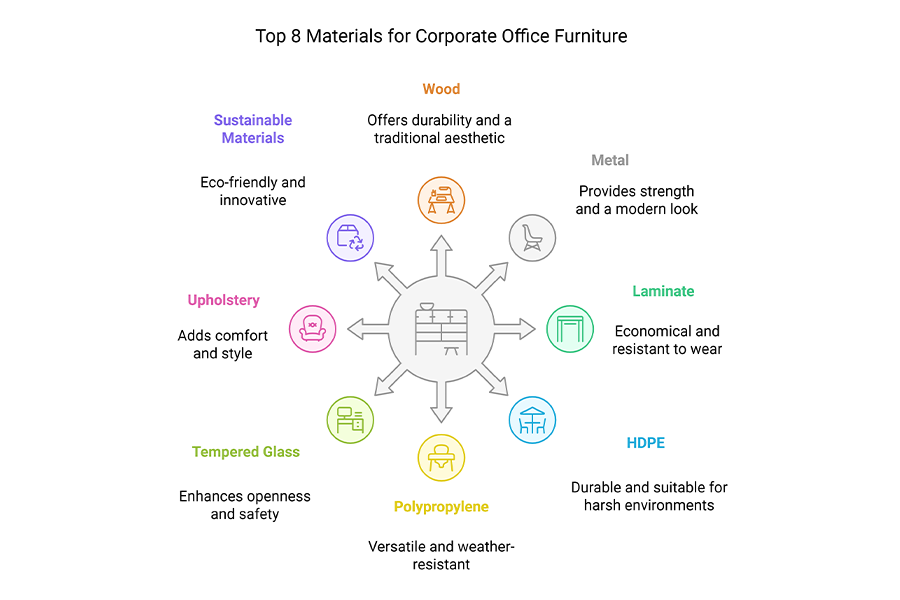Top 8 Materials for Durable Corporate Office Furniture

Corporate office furniture can take a beating.
Therefore, choosing the right material for office furniture Houston is one of the important decisions in designing and equipping a professional workspace.
Materials play a fundamental role in determining the efficiency, beauty, durability, and even economic savings of office furniture.
Office aesthetics and the comfort of employees and guests are important considerations when considering the best material for corporate office furniture.
Now the question is: Which material is best for corporate office furniture?
The best office furniture materials are wood, metal, and high-density laminate.
Wood offers durability and a professional aesthetic, metal provides strength and modern appeal, while laminate is affordable, easy to maintain, and resistant to wear.
Choose materials that balance aesthetics, functionality, and sustainability for a productive workspace.
There are several materials that corporate office furniture is made from.
Each piece of furniture is designed to meet a specific need, and the material chosen will match that need.
There are also several different finishes available, including textured, solid color, and patterns.
The goal of this article is to help businesses make more informed, cost-effective decisions tailored to their business needs by examining the types of materials commonly used in office furniture manufacturing.
The Importance of Material Durability
Choosing the right and durable office furniture material has a direct impact on its efficiency, long-term costs, and even employee health.
The materials used in office furniture not only determine the style and beauty of the work environment but also its durability, safety, and the amount of maintenance required.
In other words, the more high-quality material is chosen and more suited to the needs of the work environment, the useful life of the furniture will increase, and the frequency and cost of replacement or repair will decrease.
In a workspace that is exposed to constant use, abrasion, contact with liquids, sunlight, and sometimes temperature changes daily, using durable, standard materials can make a significant difference in the durability of office furniture.
On the other hand, choosing materials by considering ergonomic principles and interior design style helps create a cohesive and professional space.
Therefore, understanding the characteristics of various office furniture materials and considering factors such as resistance to wear and tear, ease of maintenance, compatibility with the interior space, and affordability will be essential for any business seeking to create an efficient and lasting work environment.
Now let’s see what the top 8 materials are for durable corporate office furniture.

Top Materials for Corporate Office Furniture
1. Wood
Wood and architectural grade wood veneer corporate office furniture comes in many finishes and offers combinations that are great for the modern office.
Solid wood as an office furniture material has always been appreciated for its durability and traditional, pleasing appearance.
This type of wood is a reliable option for office furniture due to its long lifespan and the ability to repair or renovate if damaged.
Species such as oak, maple, and cherry are popular choices due to their dense texture and high resistance to wear, making them ideal for making executive desks and formal conference tables.
Wood furniture is often heavier and great for executive offices. Wood veneer is a good moderate-range option.
There are several value options as well as some higher-end options, giving choices to customers who want that wood aesthetic and quality.
One of the best-selling wood veneer options is the Gesso Transform, which is the backbone of a highly functional, adaptable, and beautiful office space.
Also, engineered wood, such as MDF and plywood, which are made from a combination of wood waste with resin and glue, is considered a more economical option.
2. Metal
Metals such as steel and aluminum are other materials for durable corporate office furniture due to their high strength and modern appearance.
For this reason, many corporate office furniture options use these metals in the design and construction of office furniture.
Steel is a solid, heavier material used in long-lasting furniture.
Aluminum options are lighter weight and might be considered for offices that need to move furniture around more frequently.
These metals are especially ideal for making frames and bases for tables and chairs, providing a sturdy structure that resists deformation or bending.
Also, metal components are less susceptible to damage from impact due to their greater strength and are easier to maintain.
Kadin Tables are one example of metal corporate office furniture that offers a floating top surface, die-cast aluminum legs, and a modular substructure for exceptional stability.
Metal is mostly used in the structural and supporting parts of furniture, such as the legs, frames, and internal skeletons of chairs and tables.
This use creates stability, lightness, and a modern look to the overall design.
3. High-Pressure Laminate
Laminated furniture is an economical and durable office furniture material that can be an alternative to solid wood.
This type of furniture is made up of multiple compressed layers, the surface of which is usually covered with a wood pattern or uniform colors, and is highly resistant to scratches and stains.
Laminate’s high resistance to daily wear and tear makes it a good choice for high-traffic spaces such as reception counters, employee desks, and workstations.
This material is also known for its affordable price, wide variety of designs and colors, and easy maintenance.
High-pressure laminate, or HPL, is one of the most affordable and popular options for office furniture.
Laminate is usually suggested for clients who are looking for a unique finish and color option. It is also a great value for offices on a budget that still want the best quality corporate office furniture.
High-pressure laminate corporate office furniture is fashionable with many style options, it’s versatile because it’s both functional and decorative, plus it offers durability.
One popular high-pressure laminate corporate office furniture option is the Narrative Media Table, which is ideal for teams that need technology to collaborate on projects.
4. High-Density Polyethylene (HDPE)
HDPE, or high-density polyethylene, is a type of strong plastic that has wide applications in furniture due to its high strength-to-density ratio.
This office furniture material is particularly resistant to impact, moisture, and corrosive chemicals, making it a perfect choice for harsh environments.
Due to its high durability and low maintenance requirements, HDPE is often used in the design of outdoor office furniture, warehouse equipment, and storage solutions, where durability and resistance to environmental conditions are of particular importance.
5. Polypropylene & Polymer Plastics
Polypropylene is a common plastic used in corporate office furniture because of its dynamic expression of material science that synchronizes every movement while being strong, versatile, and durable.
Polymer is another type of plastic material that can be used for indoor corporate office furniture, but is also great for furniture used outdoors.
One example is the Bakhita Stackable Polymer Chairs, which pair well with the Bakhita Polymer Tables, which are great for outdoor use.
It’s a lightweight stacking option that features innovative molding technology.
These weather-resistant chairs offer flexibility and functionality to corporate office furniture.
Note also that there are several plastic finishes available that give a variety of color options.
6. Tempered Glass
In office furniture, the most common type of glass used is tempered glass.
To create a modern and stylish look in an office space, tempered glass is one of the best office furniture materials, which, in addition to its aesthetic appearance, also has high performance.
This type of glass is produced through a special thermal process that makes it much more resistant to impact and heat than regular glass.
If it breaks, it becomes small, harmless pieces, not sharp, cutting pieces, which is a safe option in terms of safety.
Tempered glass is an ideal choice for use in office desks, desktop partitions, and decorative areas because, while maintaining strength, it makes the space more open and bright with its transparency and lightweight appearance, without compromising on safety or durability.
7. Upholstery Materials
In office furniture design, the choice of upholstery type not only affects the appearance and style of the space but also plays a very important role in the comfort, durability, and functionality of the furniture.
The most important types of upholstery used in modern and traditional offices include mesh, felt, natural leather, and synthetic fabrics.
Each of these upholstery materials has its own unique characteristics.
Softer materials in corporate office furniture are ideal for built-in comfort.
Mesh material, like what’s used in the Vion Mesh Transitional Chair Series, combines fashion and function in a chair designed with a breathable mesh back available in a task or guest chair that is both contoured to offer total body support.
Upholstery is great for the corporate office furniture style because there are lots of textile choices.
Wind Linear Seating is a great, fully upholstered, fixed-cushion furniture option that offers style and comfort.
Felt can be used on some furniture options, but is often used for noise reduction in panels like Airbloom Acoustic Panels with modules that are made from 100% molded polyester felt fiber.
8. Innovative and Sustainable Materials
Today, with awareness of environmental issues, sustainability has become one of the main concerns of businesses.
Using innovative and environmentally friendly materials in the production of office furniture demonstrates the brand’s social responsibility and can also help improve the quality of the workspace and the company’s public image.
One of the most important new trends in furniture design is the use of recycled materials such as plastic and metal.
Natural and renewable materials also play an important role in green furniture production.
To ensure that environmental claims are true, green products usually have international certifications, so check them out.

Main Factors in Material Selection
- Durability: That is, how resistant the office furniture material is to wear, impact, scratches, and daily use.
- Aesthetics: This factor is related to the appearance of the material and how it matches the brand and interior decoration.
- Ergonomics: Office furniture materials should provide comfort, flexibility, and proper support for the user’s body.
For example, breathable fabrics or foams with the right density in office chairs prevent fatigue and pain and increase productivity.
- Maintenance: Check how easy it is to clean and maintain the furniture material you want to buy and whether it requires any special care.
- Sustainability: Pay attention to whether the office furniture material is made from renewable resources and can be recycled.
- Cost-Effectiveness: When choosing office furniture, you should consider the right combination of quality, durability, and price.
A material that seems cheap at first will be costly in the long run if it wears out quickly or needs to be replaced.
Conclusion
In this article, we learned about the types of office furniture materials.
Each material has its characteristics, advantages, and disadvantages, and the right choice will have a direct impact on the durability of the furniture, the beauty of the workspace, the comfort of your employees, and your brand image.
The important thing is that no single material is best, but the right choice is made when the specific needs of the business, type of use, budget, and design goals are fully considered.
We recommend that you carefully evaluate your workspace needs before making a purchase.
The number of employees, the type of activities, the amount of daily use of the furniture, the weather conditions, and even your brand message should all be factored into your decision.
Consulting with design experts and professional office furniture sellers can also help you make an informed and lasting choice.
Sustainability, environment, and health should also be at the forefront when choosing the best materials for corporate office furniture.
level®, BIFMA‘s sustainability certification program for furniture, is a comprehensive and transparent third-party certification program. The level mark attests that the product, the manufacturing facility, and the company responsible for the product brand have been evaluated against the multi-attribute criteria of the ANSI/BIFMA e3 Furniture Sustainability Standard. Products certified under the level program can be chosen with confidence.
Products that achieve Intertek’s ETL Environmental VOC Certification are recognized as products that safeguard indoor air quality. Corporate office furniture products that conform to the ANSI/BIFMA Furniture Emissions Standards (M7.1/X7.1-2011) for Office Furniture Systems and Components are always some of the best options.
Forest Stewardship Council® (FSC®) Chain-of-Custody(CoC) certification is an assurance that wood-based materials used in products come from forests that meet stringent environmental, social, and economic standards. It is the path taken by raw materials from the forest to the consumer, including all successive stages of harvesting, processing, manufacturing and distribution. Only products from FSC CoC companies can claim the FSC designation, assurance of a socially and environmentally responsible purchasing decision. FSC CoC certification is recognized by the U.S. Green Building Council’s (USGBC) LEED Rating System for environmentally-focused design. From a customer perspective, the FSC label represents a promise made; CoC standards are the mechanism FSC uses to ensure that promise is delivered.
Corporate office furniture in Houston, TX, should always be sustainable. It’s important for our customers throughout the US as well!
Remember: Most corporate office furniture isn’t going to consist of just one material but rather a combination of the best materials for each furniture design.
Check out this Surface Material Brochure for more details on some of the surface options available.
Written by:
John Ofield
President/CEO at Collaborative Office Interiors
Collaborative Office Interiors is a complete office furniture and systems provider in the Houston, Austin, and San Antonio areas. COI specializes in providing high-quality/low-cost solutions to companies that are moving, upgrading, or expanding.
John opened ROSI Office Systems in 1993, and the company today is on Inc. Magazine’s Top 5000 Fastest Growing Companies in 2018. John specializes in new office furniture, space planning, new workstations, Work Fit products, remanufactured Haworth cubicles, asset management, furniture liquidation, and office furniture rentals.

John Ofield is the owner of Collaborative Office Interiors. Houston’s trusted source for modern and commercial office furniture, office cubicles, demountable walls, office desks and tables, and complete workspace solutions. With more than 40 years of experience, he combines deep product knowledge with hands-on space-planning expertise to create ergonomic, productivity-focused work environments for businesses across Southeast Texas.


